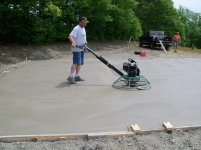This is exactly the reason that finishers spray a sealer on the slab when they finish. It slows dow evaporation of water from the concrete and produces a better finish than not using a sealer on an uncovered slab.
Concrete hardens by absorbing water, and actually needs a little more water than is provided in the original mix. The very best surface comes from providing that extra water early in the curing process.
All states, which use huge amounts of concrete for highways, know this and insist on covering concrete with wet burlap, wet straw, or old wet carpets. This is inconvenient for small-area concrete finishers, because they would have to come back and pick up the wet, soggy material several days after the job is done. This is why the sealer was developed. It provides a method for the finisher to provide an "acceptable" job without providing the extra water really needed. No return trip and the finisher is happy.
While finishers are skilled in providing the correct surface for your slab, I would not expect them to understand the chemistry of concrete curing, or to be able to give advice on anything other than their standard methods. An engineer is going to understand concrete curing and be able to advise on the best way to develop maximum strength, but don't put a trowel in his hand and expect him to deliver a good surface finish.
I have had finishers tell me that water and plastic will surely overheat the concrete and ruin it, when the truth is that it produces the strongest slab possible.
P.S. if you prepare for the job properly and have the plastic sheeting on hand to cover the slab don't let the finisher put the sealer on it -- all it will do is slow the absorption of water by the concrete.
If you really want it sealed, wait 30 days then apply a sealer meant for cured concrete. I find that the water cured concrete is harder and less permeable than most and doesn't really need a sealer.

